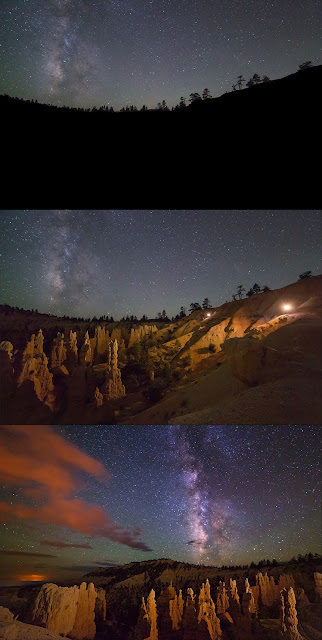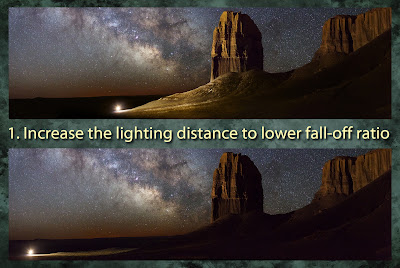 |
| Big Stable Lighthouse by Marybeth Kiczenski • Foreground taken during the blue hour, using several 15 second "focus stacked" exposures at f/8, ISO 800 • Sky is a 90 seconds tracked exposure, ISO 1000, f/2.8 • Sony a7iv camera, with a Sony 24-70mm lens at 50mm. |
 |
| Winter blooms at Anza Borrego by Marybeth Kiczenski • Foreground taken during the blue hour, using several 6 second "focus stacked" exposures at f/8, ISO 800 • Sky is five 1-minute tracked exposures (a total data stack of 5 minutes), f/2.8, ISO 800 • Sony a7iv astro modified camera (to visible + H-alpha), with a Sony 12-24mm lens at 14mm. |
Step-by-Step Tutorial
 |
A 3-image focus stack taken during the blue hour by Marybeth Kiczenski.
|
Focus stacking your night images is a great way to improve the overall image quality. Much of the process is akin to daytime focus stacking – but with a twist. Depending on if you are blue hour blending, or using true night images, the process may include further post processing.
One of the most popular case uses for focus stacking involves flowers. Flowers make beautiful foreground subjects, but with wide-angle images at F/16 – the depth of field rarely is enough for these small, yet mighty, subjects.
Before we dive in, also note that flowers move. They move A LOT. The slightest of breezes can move these delicate subjects. You may find yourself either giving up, OR doing your focus stack of the flower in blue hour – sometimes VERY early blue hour. Basically, as soon as the directional light from the sun disappears. The reason is you’ll need those faster shutter speeds to freeze the blooms.
Pay attention to the weather considerations and wind. You don’t want to miss that small window to capture still flowers!
With that out of the way, let’s get to the task at hand. You’ll notice here that the flowers here were taken not long after the sunset. While I had the tripod set up in this spot from sunset to milky way, the sharpest stack was from this early evening time frame.
Another point to consider: what is your minimum focus distance of your lens? As you can see here, the Sigma 14-24mm F/2.8 ART lens failed to catch the focus on the nearest flower to the lens. But to be fair, it was basically on top of it. If this is the type of thing that bothers you, then you’ll want to adjust accordingly. I loved having the flowers frame the scene, so I creatively chose to live with this flaw rather than losing the top anchor flower.
 |
| The yellow dots indicate the approximate focus points the camera chose in each of the three focus stack exposures. The lens aperture was set at f/8. An aperture of f/16 would have given greater depth of focus, but the exposure would have needed to be four times as long, which can cause flower movement, if there is any wind. If focus stacking had been done in total darkness (using an aperture of f/2.8), then a much great number of exposures would be needed to create the focus stack depth of focus (and focus for each would have been done manually). |
The actual focus stacking process involves you starting on the nearest subject, and progressively shifting the focus until you reach the infinity point. You can pick subjects from the scene to focus on, shift your lens step by step, or utilize some camera’s ability to in-camera focus stack. This image was done with a Nikon D850 – the first camera from Nikon to have this feature built in. The number of images you’ll need also depends on the aperture you choose. In other words, you’ll need a lot more images to complete the stack at F/2.8 vs. F/16. You may have to play around (if your camera doesn’t have the auto feature) to make sure you get everything in focus.
IMPORTANT NOTE: If you are doing your focus stacking in the dark – you’ll have to manually focus on your different points. This can be an issue if you are with a group, as the “easy” way to focus on the subject is to shine a light on it, set the focus, then turn it off. Communication is key! For this reason, (as well as the aforementioned weather issues), 95% of all my own complex foreground will likely be blue hour foregrounds. There are times where this just isn’t possible, so you just deal with the parameters dealt!
After you collect all your in-field data (focus stack images and your starry night sky exposure), it’s time to do the process the focus stack:
- Open your best sequence in the editing software of your choice.
- Apply your basic edits.
- Save the edited images.
- From here, you can use Adobe Photoshop, or software such as Helicon Focus. For images that Photoshop has issues with, I will use Helicon. [Update: recent Photoshop updates drastically improved its built in focus stacking algorithm.]
- Open the files as a stack.
- Click on “attempt to align layers”
- Once the images are loaded into layers, I will then Auto-Align them. This just insures to me that they are aligned to the best of the computer’s ability to do so.
- Select all the aligned layers, then click “Auto-Blend” The Auto function typically will suffice.
The computer will then apply masking as it sees fit to make a seamless blend. Photoshop uses depth mapping for this type of stacking. When that doesn’t work correctly, that’s where Helicon Focus comes into play. This program features different algorithms to figure out the focus shifting beyond the scope of Photoshop. You can pick between these algorithms and see how it changes the stack.
Once you are happy with your focus stacked image, save that file out. From here we will now go into adding in the sky, and color matching the two assets to make a final composition!
PUTTING IT ALTOGETHER
At this point, you should have two main images to work with:
- Focus stacked foreground image
- Single exposure / a Stacked exposure / or a Tracked sky image
Open the focus stacked image. From here you’ll want to apply a mask to remove the sky. This can be a number of ways. The easiest of which is using Photoshop’s new “Select Sky” function. This works remarkably well for well defined horizons. I find that it starts to struggle with trees. Sometimes it will remove too much detail in these complex areas. It’s always worth a try, though! As it's the easiest method!
If this fails, you can deploy the very powerful color-channel masking method. This is a bit advanced, but it's remarkable – especially when dealing with trees. Here’s the simplified process:
- In the layers panel, navigate to the color channels tab.
- Click on each channel until you find the one that separates the foreground from the sky the best. Usually this ends up being the blue channel, but not always.
- Copy that color channel into its own new layer. This step is IMPORTANT, as if you don’t copy it, any changes you make will affect the master image.
- Use brightness/contrast to create more separation. You want a black and white image.
- Use the dodge and burn tool to define the edges.
- Once happy, then select one of the colors – either black or white.
- Click back to the full color image – and click on “apply mask”.

|
| Masked Focus-stacked foreground — ready to be blended with starry night sky image |
Once the sky is masked out, then you can open your sky image. Copy that image over to the foreground image into its own layer. I always put the sky under the foreground.
Now save this master file out as a new file. This way you still have an unaltered focus stacked image, in case things go drastically wrong.
 |
| Initial blend of foreground focus-stack and sky exposure |
COLOR BLENDING
Here’s where your creativity begins to take flight! Using the Hue/Saturation, Color Balance, and Selective color under Adjustments, start working the colors until the foreground begins to match the sky, or vice versa. This is really a personal preference. Blue hour images – as the name implies – are heavy in the blue/magenta tones. Some will choose to keep with this theme, and make the night sky match the blue tones. However, the colors of the natural night sky are not blue. So you have to make this creative choice.
The magic is really in the color matching for creating convincing compositions. It can take a lot of small finessing and adjustments, and practice.
Once you are happy with the color matching, then you can take the editing further with curves, brightness, contrast, using the Nik collection, and more!
 |
| Final post-processed blend |





























